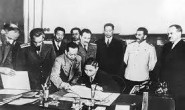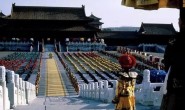来源:民族学刊 作者:[美]托马斯 S·墨垒宁/著,郎丽娜/译
注释:
①这是墨垒宁先生的《与国家达成共识——现代中国的民族识别》(加利弗尼亚大学出版社2011)一书中的第一章中的一部分,该章的题目是“后帝国时代中国身份认同危机”,我们取出其中的关于中华人民共和国实行“民族”识别的历史动因部分译出。题目为译者所加。
②题词,18页:毛泽东,“论十大关系”,毛泽东选集,第五卷(北京:外文出版社,1977)。
③小标题为译者所加,下同。
④早期中华人民共和国行政政策概观,特别是自治区的形成,见Henry Schwarz(亨利·施瓦兹),Chinese Policies Towards Minorities: An Essay and Documents (Bellingham: Western Washington State College Program in East Asian Studies, 1971)。
⑤邓小平,《关于〈中华人民共和国全国人民代表大会选举法〉草案的说明》,《民族政策文选》(乌鲁木齐:新疆人民出版社,1985),201。
⑥如上。比如一个十万人口的县,规定一千人选一个代表,而某一聚居的少数民族的人口在一万以下,则它可以少于一千人选代表一人,但最少不得少于五百人选代表一人。凡聚居境内的同一少数民族的总人口数占境内总人口数百分之十以上者,其每一代表所代表的人口数,应相当于当地人民代表大会每一代表所代表的人口数。这一附文是为了阻止那些少数民族人口较多的县和省在他们各自的人民代表大会中拥有比例不相称的非汉族人民代表数。
⑦中央人民政府民族事务委员会,《中国少数民族简表——补充版》(北京:民族事务委员会,1951)。
⑧民族列表,见附录A。云南省民政厅民族事务委员会,《云南兄弟民族主要分布地区简图》,YNPA,全部2152,索引3,文件3(1951年7月20日):5。
⑨民族列表,见附录B。云南省民族事务委员会,云南兄弟民族主要分布地区略图,YNPA,全部2152,索引3,文件4(1953年):1。
⑩见附录A和附录B中有每一个地区完整的族群名称(ethnonyms)列表。注:总的群体的数目达不到125个,因为其中有一些群体没有人口数据。
“云南省选举工作报告——初稿”YNPA,全总14,索引2,文件84以前的大陆政体已经尝试了两次直接的列举,但每一次都没能将他们列举出来。见Chen Ta,”The Beginnings of Modern Demography,”American Journal of Sociology 52(1947): 7-16Chen Ta列举了在帝国时期的两次失败的尝试——和全国性的列举,第一次由晚清维新派计划实施,但在1911年革命时失败;第二次定于1947年实施,但最终也放弃了。
John S Aird, The Size, Composition, and Growth of the Population of Mainland China (Washington, DC: US Government Printing Office, 1961); “La Recensement de la Chine : Methodes et Principaux Resultats,” Population 11, no 4 (October-December 1956), 734 详细查看《现代中国人口普查的演变》,见Ping-ti Ho, Studies on the Population of China,1368-1953 (Cambridge, MA: Harvard University Press, 1959)。
Marc SAbramson, Ethnic Identity in Tang China (Philadelphia: University of Pennsylvania Press, 2008 ); Hoyt Tillman, “Proto-Nationalism in Twelfth-Century China? The Case of Ch’en Liang,” Harvard Journal of Asiatic Studies 39, no 2 (1979): 403-28 对于在这次辩论上形成的有趣的观点,见 Pamela Kyle Crossley, “Thinking about Ethnicity in Early Modern China,” Late Imperial China 11, no 1 (1990): 1-35; Mark C Elliott, “Ethnicity in the Qing Eight Banners,” in Empire at the Margins: Culture, Ethnicity, and Frontier in Early Modern China, ed Pamela Kyle Crossley, Helen F Siu, and Donald S Sutton (Berkeley: University of California Press, 2006), 27-57。
She Yize,《中国土司制度》(重庆:正中书局,1944)。
Peter Perdue, China Marches West: The Qing Conquest of Central Eurasia (Cambridge, MA Harvard University Press, 2005)。
Mark C Elliott, The Manchu Way: The Eight Banners and Ethnic Identity in Late Imperial China (Stanford: Stanford University Press, 2001)。更多关于清朝在北方的殖民统治,见James Millward, Beyond the Pass: Economy, Ethnicity, and Empire in Qing Central Asia, 1759-1864 (Stanford: Stanford University Press, 1998); Nicola Di Cosmo, “Qing Colonial Administration in Inner Asia,” International Historical Review20, no 2 (June 1998): 287-309; Peter Perdue, “Empire and Nation in Comparative Perspective:Frontier Administration in Eighteenth-Century China,”Journal of Early Modern History 5, no4 (November 2001): 282-304; Perdue, China Marches West。
Pamela Crossley, A Translucent Mirror: History and Identity in Qing Imperial Ideology (Berkeley: University of California Press, 1999)。
Evelyn Rawski, “Presidential Address: Reenvisioning the Qing: The Significance of the Qing in Chinese History,” Journal of Asian Studies 55 (November 1996)。
Nicola Di Cosmo, “Qing Colonial Administration in Inner Asia, “International Historical Review 20, no2 (June 1998): 287-309; James Millward, Beyond the Pass: Economy, Ethnicity, and Empire in Qing Central Asia, 1759-1864 (Stanford: Stanford University Press,1998); Peter Perdue, China Marches West: The Qing Conquest of Central Eurasia (Cambridge, MA: Harvard University Press, 2005)。
C Patterson Giersch, Asian Borderlands: The Transformation of Qing China’s Yunnan Frontier (Cambridge, MA: Harvard University Press,2006)。
John E Herman, “Empire in the Southwest: Early Qing Reforms to the Native Chieftain System,” Journal of Asian Studies 56, no1(February 1997): 47-74。
Giersch, Asian Borderlands, 45又见 Louisa Schein, Minority Rules: The Miao and the Feminine in China’s Cultural Politics (Durham: Duke University Press, 2000) 又见Dai Yingcong, “The Rise of the Southwestern Frontier under the Qing, l640-1800″(PhD diss, University of Washington, 1996)。
Giersch, Asian Borderlands, 61-62。
同上,第四章。
同上,190更多关于清朝在西南的政策,尤其特别关注汉族迁移所带来的潜在的不稳定的影响,见 David Bello, “To Go Where No Han Could Go for Long: Malaria and the Qing Construction of Ethnic Administrative Space in Frontier Yunnan,” Modern China 31, no 3 (July 2005): 283-317。
David Atwill, The Chinese Sultanate: Islam, Ethnicity, and the Panthay Rebellion in Southwest China,1856-1873(Stanford:Stanford University Press, 2005), 67-68 当我们看戴维龙的说明时,唐纳德·萨顿(donald Sutton)所做的工作,对于我们去了解在帝国晚期对居住在清朝边境的民族所实施的暴力的维度,提供了一个更广阔的背景。见 Donald S Sutton, “Violence and Ethnicity on a Qing Colonial Frontier,” Modern Asian Studies 37, no 1 (2003): 41-80。
Atwill, Zhe Chinese Sultanate, 70-76。
Kai-wing Chow, “Imagining Boundaries of Blood: 章炳麟 and the Invention of the Chinese Race in Modern China,” in Racial Identities in East Asia, ed Barry Sautman (Hong Kong: Hong Kong University of Science and Technology, 1995); Dru Gladney, Muslim Chinese: Ethnic Nationalism in the People’s Republic (Cambridge, MA: Harvard University Press, 1991); Prasenjit Duara, Rescuing History from the Nation: Questioning Narratives of Modern China (Chicago: University of Chicago Press, 1995)。
值得提醒的是,这些过程不等同于中国化,伊夫林·罗斯基(Evelyn Rawski)阐明了这一点。见Evelyn Rawski, “Presidential Address”;何炳棣(Ping-Ti Ho),“In Defense of Sinicization: A Rebuttal of Evelyn Rawski’s ‘Reenvisioning the Qing,’”Journal of Asian Studies 57 (February 1998) Beyond Confucian and Chinese practice, the Manchu had positioned themselves as patrons of their other imperial subjects as well, including the Mongolians and Tibetans See Harold L Kahn, Monarchy in the Emperor’s Eyes: Image and Reality in the Ch’ien-lung Reign (Cambridge, MA: Harvard University Press, 1971); David M Farquhar, “Emperor as Bodhisattva in the Governance of the Ch’ing Empire,” Harvard Journal of Asiatic Studies 38, no1(1978): 5-34。
审查汉满两族在世纪之交的关系,见爱德华·J·M·罗德(Eedward J M Rhoads ),Manchus and Han: ethnic Relations and Political Power in Late Qing and Early Republican China, 1861-1928 (Seattle: University of Washington Press, 2001)关于民族主义的复杂性和章炳麟的反满思想,见考科·莱蒂宁(Kauko Laitinen ),Chinese Nationalism in the late Qing Dynasty:章炳麟 as art Anti-Manchu Propagandist (London: Curzon Press,1990)又见Young-tsu Yong,Search for Modern Nationalism,章炳麟and Revolutionary China, 1869-1936 (Hong Kong: Oxford University Press, 1989)有趣的是,张在反满族思想这一问题上的矛盾,在早期曾被约书亚·福格尔( Joshua Fogel)提出,当时他还是哥伦比亚大学的一名研究生。见约书亚 A·福格尔( Joshua A Fogel),”Race and Class in Chinese Historiography: Divergent Interpretations of章炳麟 and Anti-Manchuism in the 1911 Revolution,” Modern China 3, no 3 (July1977): 346-75了解更多晚清时期的反满信息,见沙培德(Peter Zarrow),“Historical Trauma: Anti-Manchuism and memories of Atrocity in Late Qing China;”History and Memory 16, no 2 (2004年秋或冬): 67一107; Ishikawa Yoshihiro “Anti-Manchu Racism and the Rise of Anthropology in Early 20th Century China; Sino-Japanese Studies 15 (April 2003): 19-26; Ishikawa Yoshihiro, Racialism during the Revolution of 1911 and the Rise of Chinese Anthropology (Beijing: Central Literature Press, 2002) 对于当代反满宣传的腐蚀性例子之一,见邹荣(Tsou Jung),1903年出版的革命军:一本中国民族主义的小册子, trans John Lust (The Hague: Mouton,1969)。更多关于达尔文的进化论和社会达尔文主义的理论被介绍到中国,见詹姆斯·里夫蒲赛(James Reeve Pusey,China and Charles Darwin (Cambridge, MA; Harvard University Press, 1983)。
Chow,“Imagining Boundaries of Blood,”157 对于更多有关“族”和“民族”话语的中心地位在表达反满时的位置,见 Kai-wing Chow, “Narrating Nation, Race and National Culture: Imagining the Hanzu Identity in Modern China,”in Constructing Nationhood in Modern East Asia, ed Kai-ruing Chow; Kevin Doak, and Poshek Fu (Ann Arbor: University of Michigan Press, 2001), 47-83。
同上。
Rhoads, Manchus and Han, 291 颠覆性的民族话语也找到了进入晚清乡土教材的方式。对于最近的一个有趣的研究,见 May-bo Ching, “Classifying Peoples: Ethnic Politics in late Qing Native Place Textbooks and Gazetteers,” in The Politics of Historical Production in Late Qing and Republican China, ed Tze-ki Hon and Robert Culp (Leiden: Brill, 2007), 55-78。
Edward JMRhoads, Manchus and Han; Ethnic Relations and Political Power in Late Qing and Early Republican China, 1861-1928 (Seattle: University of Washington Press, 2000)。
Joseph W Esherick,”How the Qing Became China,”in Empire to Nation: Historical Perspectives on the making of the Modern World, ed Joseph W Esherick, Hasan Kayali, and Eric Van Young (Lanham,MD: Rowman &Littlefield, 2006), 243-45。
Elliott, The Manchu Way 对于八旗制度及其它在满族认同形成中所起的作用作出的一个更简明地概述,见 Elliott, “Ethnicity in the Qing Eight Banners” 除了埃利奥特的说明,又见Ning Chia,“The Lifanyuan and the Inner Asian Rituals in the Early Qing (1644-1795)”Late Imperial China 14, no 1(June 1993):60-92, Evelyn SRawski, The Last Emperors: A Social History of Qing Imperial Institutions (Berkeley:University of California Press,1998); Crossley, A Translucent Mirror; Peter Perdue,Empire and Nation in Comparative Perspective。”
对于更多有关从帝国到民族国家这种麻烦的过渡。见帕梅拉·克罗斯利(Pamela Crossley),“Nationality and Difference: The Post-Imperial Dilemma,”Late Imperial China 11, no1(1990):1-35。
约瑟夫·W·埃谢里克,(Joseph W Esherick),“How the Qing Became China,”248-52。
对于在20世纪上半期深入研究蒙古族,见Xiaoyuan Liu,Rains of Liberation:An Entangled History of Mongolian Independence,Chinese Territoriality,and Great Power Hegemony,1911-1950(Stanford:Stanford University Press,2006)。
Lin Hsiao-ting,Tibet and Nationalist China’s Frontier: Intrigues and Ethnopolitics,1928-49 (Vancouver: University of British Columbia Press,2006)。
“五族共和”也可以翻译为“五个种族(five race)”。尽管“种族”这一翻译的确是获取本质主义思想的一项好的做法,但是它掩盖了五族形成的前现代源头,以及与在清八旗制度下所做的分类的关系。使用种族这一术语暗含了与过去划清界线,和基于现代主义基础上的一个新的形成,这是达尔文(darwinian)的概念。“五个民族(five peoples)”避免了这种现代主义的偏见。另一个有吸引力的替代是“五种血统(five lineages)”,是最近由詹姆斯·雷鲍德(James Leibold)建议的。见James Leibold,“Competing Narratives of Racial Unity in Republican China:From the Yellow Emperor to Peking Man,”Modern China 32,no2(2006年4月):181-220。
约翰·菲茨杰拉德(John Fitzgerald),Awakening China:Politics,Culture,and Class in the Nationalist Revolution (Stanford:Stanford University Press,1988),183;詹姆斯·雷鲍德(James Leibold),“Positing ‘民族’within Sun Yat-sen’s Discourse of ‘民族主义’,Journal of Asia History 38,nos1-2:163-213在一些方面,从帝国到民族国家的转变也同样带来了类似于日本的挑战。依据不同的边界逻辑,已经继承了德川的领土,在一个日本帝国领域其他的部分和被排除的部分,明治日本国家选择去扩展不能分化的主权。见大卫·L·豪威尔(David LHowell),“Ainu Ethnicity and the Boundaries of the Early Modern Japanese State,”Past and present142(1994年2月):69-93。
DKLieu,“The1912 Census of China,” Bulletin de l’Institut International de statistique 26,第2(1931):85-109。
苏联领导人敦促中国共产党将民族解放事业扩大到边境地区。通过中国共产党的言论,他们企图压制国民党对居住在边界的少数民族实施半自治状态的统治,同时这一政策已经促进了苏联在蒙古和新疆的持续的影响。见Xiaoyuan Liu,Frontier Passages: Ethnopolitics and the Rise of Chinese Communism,1921-1945(Stanford:Stanford University Press,2004)。
哈罗德·J·威恩斯(Herold J Wiens),China’s March Toward the Tropics: A Discussion of the Southward Penetration of China’s Culture, Peoples and Political Control in Relation to the Non-Han-Chinese Peoples of South China and in the Perspective of Historical and Cultural Geography (Hamden, CT: Shoe String Press,1954), 151-152。
Xiaoyuan Liu,Frontier Passages,23-24。
弗兰克(Frank Dikotter),The Discourse of Race in Modern China (London: Hurst, 1992)。
帕特丽夏·斯特拉纳汉(Patricia Stranahan),Underground:The Shanghai Communist Party and the Politics of Survival, 1927-1937 (Lanham, MD: Rowman &Littlefield, 1998)。
蒋介石,《中国之命运》,第二次修订,编缉(1943;1947;重印,台北:中正书局,1986),73;Liu,Frontier Passages,73。
“Constitution of the Soviet Republic” (November 7, 1931), in Schwarz, Chinese Polities Towards Minorities。
同上,49。
哈里森·E·索尔兹伯里(Harrison E Salisbury),长征,(New York Harper and Row, 1985),107-8。
格拉德尼(Dru Gladney),Muslim Chinese, 87 除了格拉德尼的叙述,又见林黄明(Lin Huangming),“红军长征与民族工作”,长征大事典编委会,卷2,编缉,长征大事典(贵阳:贵州人民出版社,1996):2046-2051。
Liu,Frontier Passages,80。
詹姆斯·雷鲍德(James Leibold),“Competing Narratives of Racial Unity in Republican China”。
蒋介石,《中国之命运》,13这一问题出现在1947年的版本中,而不是出现在1943年的原版本中。在大多数情况下,事实上,1947年版比原版更公开主张社会同化和单基因遗传。
埃利奥特(Elliott),The Manchu Way。
蒋介石,《中国之命运》,20-21。
黄帝祖先的神话已经被詹姆斯·雷鲍德(James Leibold)巧妙地处理。见James Leibold,“Competing Narratives of Racial Writing in Republican China: From the Yellow Emperor to Peking Man,” Modern China 32, no 2 (2006): 181-220。
戴维·迈克尔(David Michael Deal),”National Minority Policy in Southwest China, 1911-1965″(PhD diss, University of Washington, 1971), 56。
民族问题研究会,编辑,回回民族问题(北京:民族出版社,1980)。
同上,67。
同上,69。共产党理论家和宣传者陈伯达(Chen Boda)也提出了反对蒋介石的中国之命运的宣言。见陈伯达,“评‘中国之命运’”,民族问题文献汇编,编缉,中共中央统战部(北京:中共中央党校出版社,1991)。
A Study of the Ethnic Policies of China: Focusing on”Ethnic Theories” from the Late Qing until 1945 (Tokyo: Taga Shuppan, 1999)王建民,《中国民族学史》(上)(昆明:云南教育出版社,1997),228。
陈廉贞和黄操良(Chen Lianzhen, Huang Caoliang),《抗战中的中国民族问题》(海口:黎明书局,1938),8。
同上。
见沃克S康纳(Walker S Connor), The National Question in Marxist-Leninist theory and Strategy (Princeton: Princeton University Press, 1984)。
陈廉贞和黄操良(Chen Lianzhen, Huang Caoliang),抗战中的中国民族问题,44。
戴维·迈克尔(David Michael Deal),“National Minority Policy in Southwest China,”59-60。
亨利·施瓦兹(Henry Schwarz),Chinese Policies Towards Minorities,52-53 。
同上。
黄光学,编辑,《当代中国的民族工作(上)》,(北京:当代中国丛书编缉委员会,1993),66。
约翰·德范克(John DeFrancis),“National and Minority policies”,Annals of the American Academy of political and Social Science 277 (1951),154当然,在共产主义的早期,国家整合推广的努力超越了民族政治的管理。对于从一个更广阔的视角来看待中华人民共和国早期云南的管理,见多萝西·J·索林杰( Dorothy J Solinger),Regional Government and Political Integration in Southwest China,1949-1954:A Case Study(Berkeley:University of California press,1977)。
约翰·赫尔曼(John Herman),“The Cant of Conquest:Tsui Officies and China’Political Incorporation of the Southwestern Frontier,”in Empire at the Margins: Culture, Ethnicity, and Frontier in Early Modern China,ed Pamela Kyle Crossley, Helen FSiu,and Donald SSutton(Berkeley:University of California Press,2006),135-70; 黄光学,《当代中国的民族工作(上)》,46。
转载请注明:北纬40° » 现代中国多民族国家策略



